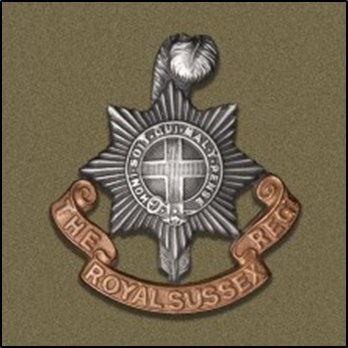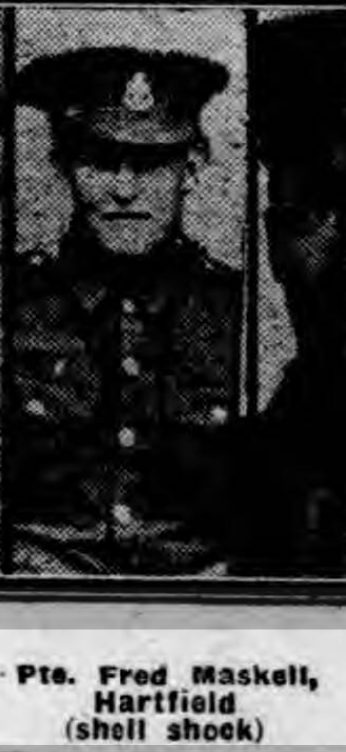HARRY GEORGE MASKELL
Private, G/607, 7th Battalion, Royal Sussex Regiment
Killed in Action on 1 August 1916 near Thiepval, Somme, France, aged c.20
Commemorated on the Thiepval Memorial: Pier and Face 7c

The Cap Badge of the Royal Sussex Regiment
(Click to enlarge)
The name HW Maskell on Hartfield War Memorial appears at first glance to refer to Harry Walter Maskell who was born at Wadhurst in 1896 but moved to Hartfield with his family a few years later. However, despite being the obvious candidate the story turns out to be much more complex, and the memorial should actually be commemorating Harry Walter's second cousin, Harry George Maskell.
Harry George Maskell, Private G/607, 7th Battalion, Royal Sussex Regiment, who was killed in action on 1 August 1916, was born in Mayfield to William and Alice Maskell (née Snow). He was baptised as Henry George on 3 May 1896, so was of a similar age to his cousin. He was the third of seven children: Frederick and Ernest, his older brothers, also served in World War I. Ellen, John, Arthur and Emily were all younger than Harry. All the children were born at Mayfield, and the family was living at Fletching Street there in 1901, along with Harry's grandfather, Trayton Maskell. By 1911 they had moved to Burnt Oak Cottages in Waldron; presumably William moved his family to wherever there was work. William was an agricultural labourer, and although Harry is enumerated as a baker in the 1911 census, he later returned to the land as he is reported as working for a farmer named Mr Eaton at Mayfield.
At the outbreak of war, Harry was quick to join up, enlisting from Mayfield (as reported by the local press) in the Royal Sussex Regiment at Eastbourne on 4 September 1914. By now, his family had moved again, and had been living in Groombridge for about a year. Just over a year after he joined up, Harry was wounded. On 22 October 1915, the Kent and Sussex Courier reported:
LOCAL MAN WOUNDED. - Mr and Mrs Maskell of Birchden Cottages, Groombridge, have received an intimation that their son, Pte Henry Maskell, of the 9th Battalion Royal Sussex Regiment has been wounded...Until about two years ago the family lived in Mayfield, where Henry Maskell was employed by Mr Eaton.
Twenty-year-old Harry was in hospital in Newcastle following a severe gunshot wound to the hip. However, in a letter home, he told his parents that he was 'going on nicely'.
It may have been on his return to the front that he was transferred from the 9th battalion to the 7th, unless the newspapers placed him in the wrong battalion, and he was in the 7th all along. The following year, Harry's death was reported in three separate papers, in the first two under the various headings Mayfield and Hartfield. The Surrey Agricultural Express of 18 August 1916 wrote that Harry had come home:
some months ago, wounded, returning to his regiment...about eight weeks ago.
It also noted that Harry's brother Fred was in hospital wounded and that a second brother, Ernest, was also 'out doing his bit'. On the same day, the Kent and Sussex Courier reported that:
Harry Maskell, son of Mr Wm. Maskell, of Bolebrook Cottages, was killed in action on August 1st. He joined the 9th Royal Sussex, soon after war was declared. He was wounded on September 25th last, returned to France on July 12th, and was killed on August 1st. He was only 20 years of age. Previous to joining the Army he was employed by Mr Eaton, Hooper's Farm, Mayfield.
The report goes on to say that Harry's brother Fred was in hospital suffering from shell-shock and that Ernest had been wounded the previous year and mentioned in dispatches for great coolness under shell-fire.

Report of Fred Maskell's shellshock
(Click to enlarge)
The East Grinstead Observer added a further detail on the following day:
He [Harry] joined up at the outbreak of war and was wounded at Ypres [sic]. He was home on leave at Hartfield a few weeks ago.
The 7th Battalion was part of Kitchener's 'New Armies', formed initially in September 1914, and as all original recruits had the prefix G on their regimental numbers. The battalion, as part of the British Expeditionary Force, landed in Boulogne for active service on the Western Front on 31 May/1 June 1915. In September that year, Harry would have seen action at the Battle of Loos, which is no doubt where he was wounded. In July 1916 he may have been involved in the end of the engagement at Albert (1-13 July) and was almost certainly at Pozières (23 July). These two engagements were part of the larger Battle of the Somme. However, the likelihood, given the date of his death, is that he was killed at Gueudecourt, where two officers and 41 other ranks were killed on 1 August 1916.

Location of Gueudecort, Picardy
(Click to enlarge)
By the time of his death Harry would have endured the full horror of two weeks of the Battle of the Somme, in which 20,000 men died on the first day. The allied high command believed that a week's shelling of the German trenches had destroyed their fire power. Unfortunately, this was not so, and men went over the top into a hail of machine-gun fire.
Harry's mother Alice received his effects and war gratuity in 1919, proving once again that the man in question was Harry George not Harry Walter.

War Gratuity of Harry Maskell left to his Mother
(Click to enlarge)
Harry Maskell appears on the Mayfield Roll of Honour which lists:
the names of the men from the parish who have made the supreme sacrifice
as published in the Kent and Sussex Courier on 1 March 1918, but ironically, his name is missing from the list of names on the Hartfield Memorial compiled for the Kent and Sussex Courier of 15 October 1920, though his cousins Mark and George Maskell appear. Other names on the memorial are also missing from the list.
Harry George Maskell appears on the Mayfield Roll of honour online. This also notes that he was employed at one time by Lesters the bakers. He is also listed on the Eridge Green memorial. Neither Thiepval, Mayfield nor Eridge records his second name.
It is not yet known definitively how Harry — or Henry George — Maskell came to be commemorated on the Hartfield Memorial as HW Maskell. His branch of the family had only fairly recently moved to Hartfield, and Harry was working at Mayfield immediately prior to joining up. I had thought that perhaps he was not well known to the local community, and someone changed his initials on a list mistaking him for Harry Walter. In fact, Harry Walter had enlisted in 1915 as Harry Henry, and lost an arm in battle before being honourably discharged as unfit to fight. He later married, and died at a relatively old age. However, it seems now that the error occurred later, as, according to Burslem Stonemasons, Pte Harry Maskell was listed as one of the names to be added to the memorial when it was re-cut in 2014. As the stone masons only had the name Harry on their list, it is still a mystery as to why the initial W was added. If anyone can shed light on this, please get in touch.
Pam Griffiths
9 November 2018

